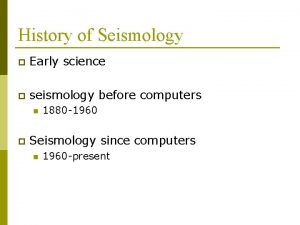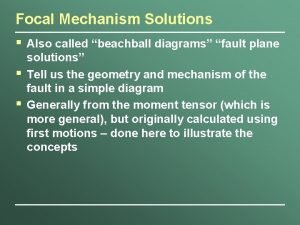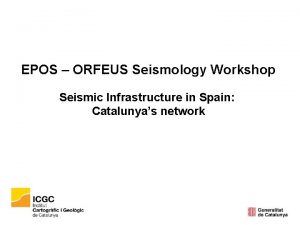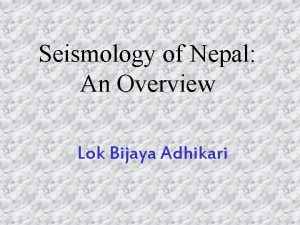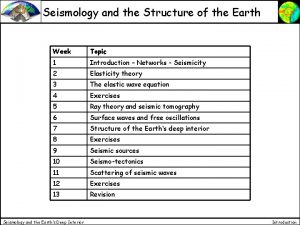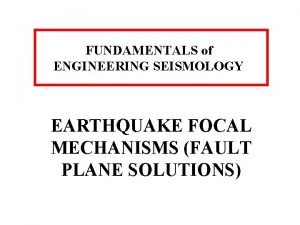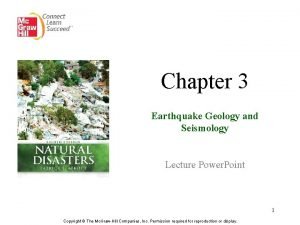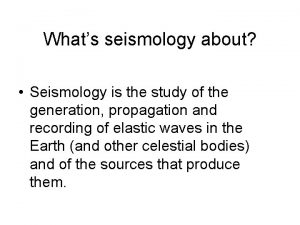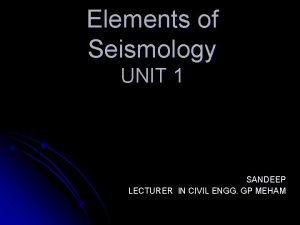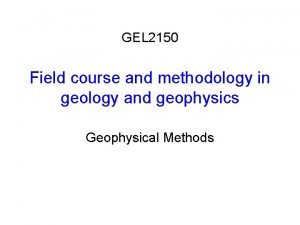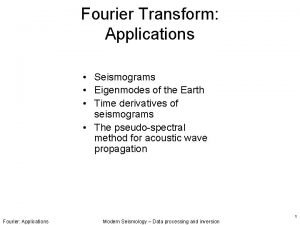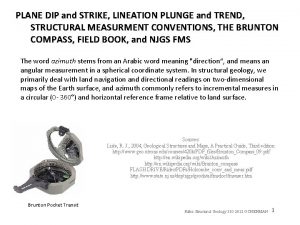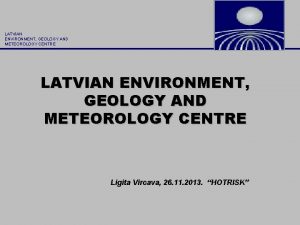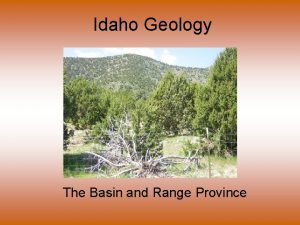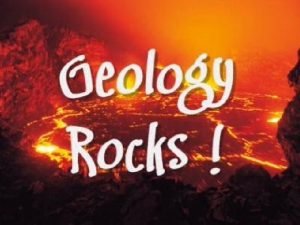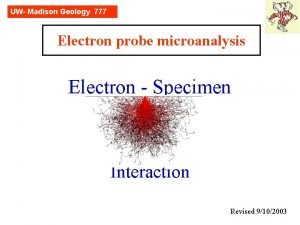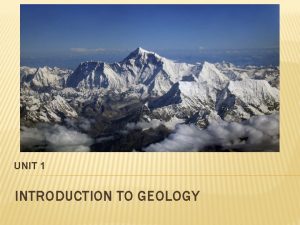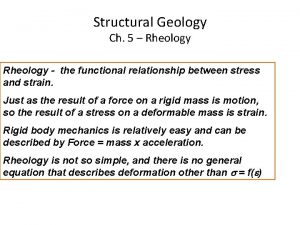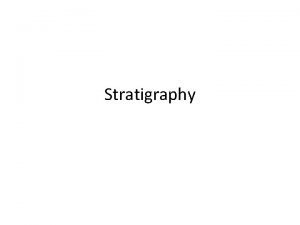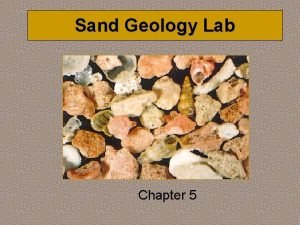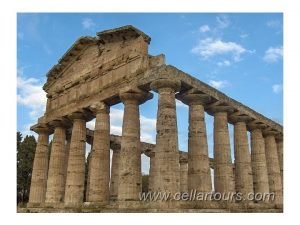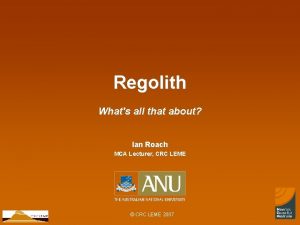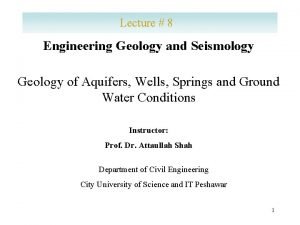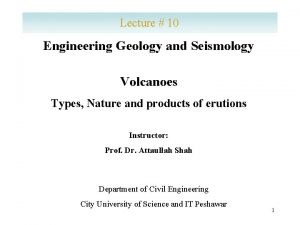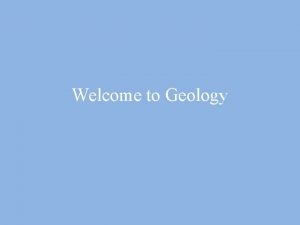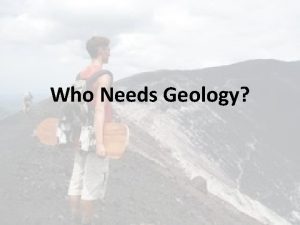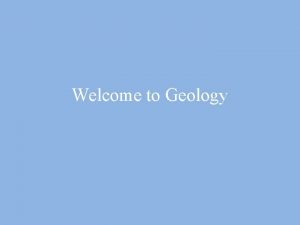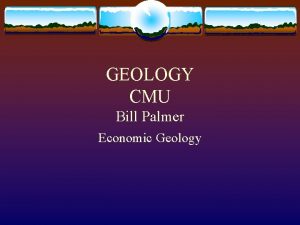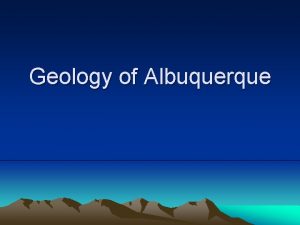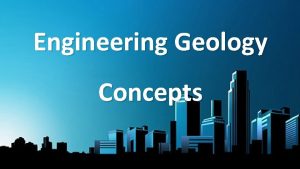1 Lecture 1 Engineering Geology and Seismology Origin





























- Slides: 29

1

Lecture # 1 Engineering Geology and Seismology Origin and Interiors of the Earth Instructor: Prof. Dr. Attaullah Shah Department of Civil Engineering City University of Science and IT Peshawar 2

Civil Engineering- Program Educational Outcomes The graduates of Civil Engineering Program after 4 -5 years of graduation will: PEO 1: Successfully practice Civil Engineering at the highest professional levels to serve national, and international industries and government agencies; PEO 2: Have the necessary background and technical skills to work professionally in one or more of the areas of environmental engineering, geotechnical engineering, structural engineering, transportation engineering, water resources engineering and other related fields; PEO 3: Be prepared and commitment to their ethical and social responsibilities to work for the safety of society, both as individuals and in team environments; PEO 4: Be motivated for, and capable of pursing continued life-long learning through further graduate education, or other training programs in engineering or related fields. 3

× Life Long Learning PLO 12 × Project management PLO 11 × Communication PLO 10 Individual and Team work PLO 9 Ethics PLO 8 Environment and Sustainability PLO 7 × Engineer and Society PLO 6 Be motivated for, and capable of pursing continued life-long learning through further graduate education, or other training programs in engineering or related fields. Modern Tools Usage PLO 5 PEO 3: Be prepared and commitment to their ethical and social responsibilities to work for the safety of society, both as individuals and in team environments; Investigation PLO 4 PEO 2: Have the necessary background and technical skills to work professionally in one or more of the areas of environmental engineering, geotechnical engineering, structural engineering, transportation engineering, water resources engineering and other related fields; × Design Development PLO 3 PEO 1: Successfully practice Civil Engineering at the highest professional levels to serve national, and international industries and government agencies; Problem Analysis PLO 2 Program Learning Objectives (PLO) Knowledge PLO 1 Program Educational Objectives (PEO) × × × ×

Engineering Geology Course Objectives/Outcomes: At the end of the semester students should be able to: • CLO 1: Understand the basic science of geology and geological process. • CLO 2: To know and understand the properties of common rock forming minerals and rock types. • CLO 3: To understand basic structural geology • CLO 4: To understand the role of geology in the Civil Engineering Structures and other geological phenomenon such as Land slides, Glaciers, Volcanoes etc. 5

Life Long Learning PLO 12 × Project management PLO 11 × Communication PLO 10 CLO 4: To understand the role of geology in the Civil Engineering Structures and other geological problems such as Land slides, Glaciers, Volcanoes etc × Individual and Team work PLO 9 CLO 3: To understand basic structural geology. Ethics PLO 8 × Environment and Sustainability PLO 7 Engineer and Society PLO 6 CLO 2: To know and understand the properties of common rock forming minerals and rock types. Modern Tools Usage PLO 5 × Investigation PLO 4 CLO 1: Understand the basic science of geology and geological process. Design Development PLO 3 Problem Analysis PLO 2 Program Learning Outcomes (PLO) Knowledge PLO 1 Course Learning Outcomes (CLO)

Week Topic/Lecture Objectives Assessment Learning Outcomes Delivery (Hours) Course Program Lec Tutorial IS CP 1 Introduction to - Introduction to CLO-1 Geology: Geology and The Earth as a Engineering planet, Process of - Introduction to external and various theories internal origin about formation (Volcanic, of earth Metamorphic, - To identify Sedimentary) various layers of Earth and its significance of Engineering - Significance of Engineering Geology PLO-1 02 01 02 Assessment ( Tools) CBA X TA X Assignment/Activity: Visit website and some videos on the formation of earth. Team Assignments: 1. Various theories on the formation of earth 2. Interior of earth 3. The role of earth crust in human development 4. Relation of earth curst with Civil Engineering 5. Role of Engineering Geology in the Civil Engineering Practice 6. Branches of Engineering Geology 7. Various Engineering problems associated with geological Changes 8. The challenges in Engineering geology 2 Rocks formation - To introduce CLO-2 PLO-1 and classification: the students and According to the processes mode of involved in the occurrences and formation of their compositions different types. - Occurrence of Rocks and global and National 02 01 02 X X Class based Test and Assignment covering the Lecture-1 before the start of topic. Study the Rock maps of Pakistan and Discuss in the Class, the major rocks, their occurrence and Engineering uses in KPK covering the following regions. 7 -North ( Swat Buner and Kohistan) -Central ( Peshawar, Mardan Charsadda etc) -South ( Kohat, Bannu, DIK etc. )

Geology literally means "study of the Earth. “ Physical geology examines the materials and processes of the Earth. Historical geology examines the origin and evolution of our planet through time. Engineering geology is the application of geological data, techniques and principles to the study of rock and soil surfacing materials, and ground water. Seismology is study of the generation, propagation and recording of the elastic waves and the source that produce them.

Importance of engg geology in Civil Engineering practice What is Engineering Geology? • Engineering geology is the application of geological data, techniques and principles to the study of rock and soil surficial materials and ground water. • This is essential for the proper location, planning, design, construction, operation and maintenance of engineering structure. 9

Importance of engg geology in Civil Engineering practice What does Engineering Geology study? • Rock, soil, water and the interaction among these constituents, as well as with engineering materials and structures. 10

Importance of engg geology in Civil Engineering practice Why Engineering geology? • Serve civil engineering to provide information in 3 most important areas: • Resources for construction; aggregates, fills and borrows. • Finding stable foundations; • Mitigation of geological hazards; Identify proplems, evaluate the costs, provide information to mitigate the problem 11

Origin of Earth Various Theory 1. Nebular Hypothesis 2. Planetesimal Hypothesis 3. Gaseous Tidal Hypothesis 4. Binary Star Hypothesis 5. Gas Dust Clout Hypothesis 12

Nabular Hypothesis German philosopher, Kant and French mathematician, Laplace • Earth, planets and sun originated from Nebula. • Nebula was large cloud of gas and dust. It rotates slowly. • Gradually it cooled and contracted and its speed increased. • A gaseous ring was separated from nebula • Later the ring cooled and took form of a planet • On repetition of the process all other planets came into being • The central region, nebula became sun. 13

Objections to Nabular Hypothesis : • Sun should have the greatest angular momentum because of its mass and situated in the center, however, it has only two percent of momentum of the solar system • How the hot gaseous material condensed in to rings 14

Planetesimal Hypothesis Chamberlin and Moulton proposed theory in 1904 • The sun existed before the formation of planets • A star came close to the sun. • Because of the gravitation pull of the star, small gaseous bodies were separated from the sun • These bodies on cooing became small planet's • During rotation the small planets collided and form planets 15

Objections to Planetesimal Hypothesis • The angular momentum could not be produced by the passing star. • The theory failed to explain how the planetesimals had become one planet 16

Gaseous Tidal Theory Jeans and Jeffrey proposed theory in 1925 • Large star came near the sun. Due to gravitational pull a gaseous tide was raised on the surface of the sun. • As the star came nearer, the tide increased in size. • Gaseous tide detached when star move away. • The shape of the tide was like spindle. • It broke into pieces-forming nine planets of the solar system. 17

Interior of earth n n n Crust: n Continental crust (25 -40 km ) n Oceanic crust (~6 km) Mantle n Upper mantle (650 km) n Lower mantle (2235 km) Core n Outer core: liquid (2270 km) n Inner core: solid (1216 km) Values in brackets represent the approximate thickness of each layer

Layers of the Earth The earth is divided into three main layers: Inner core, outer core, mantle and crust. ØThe core is composed mostly of iron (Fe) and is so hot that the outer core is molten, with about 10% sulphur (S). The inner core is under such extreme pressure that it remains solid. ØMost of the Earth's mass is in the mantle, which is composed of iron (Fe), magnesium (Mg), aluminum (Al), silicon (Si), and oxygen (O) silicate compounds. At over 1000 degrees C, the mantle is solid but can deform slowly in a plastic manner.

THE CRUST ØThe crust is much thinner than any of the other layers, and is composed of the least dense calcium (Ca) and sodium (Na) aluminum-silicate minerals. Being relatively cold, the crust is rocky and brittle, so it can fracture in earthquakes. ØThe shell of the earth, the crust, can be said to have two different thicknesses. ØUnder the oceans, it is relatively thin. It varies in thickness from 5 to 8 km. Under the land masses, it is relatively thick. The thickness of the continental crust varies from 10 to 65 km.

THE CRUST ØThe eggshell analogy for the crust is not an exaggeration. It is paper thin compared with the radius of the earth which is approximately 6400 km. ØThe total weight of the continental crust is less than 0. 3% of the weight of the earth. ØVariations in the crust thickness are compensated by the weight of the water and the differences in the specific gravities of the crust under the oceans (3. 0 to 3. 1) and under the continents(2. 7 to 2. 8).

THE CRUST Ø If one thinks of the crust as virtually floating on the mantle, one is less likely to wonder why the earth does not wobble as it rotates about its axis. Ø The weight of the crust plus the mantle has a reasonably uniform distribution over the globe.

THE MOHO ØThe Moho, or the Mohorovicic Discontinuity, refers to a zone or a thin shell below the crust of the earth that varies in thickness from 1 to 3 km.

THE MOHO ØIn seismology, the term "discontinuity" is used in its general sense. It refers to a change over a short distance of a material property. In this case, the "short distance" may be as long as 3 km, a trifle compared with the radius of the earth. ØIn that zone, the P-wave velocity has been observed to increase from approximately 6 to approximately 8 km/sec. ØThe Moho is considered to be the boundary between the crust and the mantle. ØThe increase in P-wave velocity is ascribed to change in composition of the medium. Rocks of the mantle are poorer in silicon but richer in iron and magnesium

THE MANTLE The mantle can be thought of having three different layers. The separation is made because of different deformational properties in the mantle inferred from seismic wave measurements. (1) The upper layer is stiff. It is presumed that if the entire mantle had been as stiff, the outer shell of the earth would stay put. This stiff layer of the mantle and the overlying crust are referred to as the lithosphere. The lithosphere is approximately 80 -km thick

THE MANTLE (2) Beneath the lithosphere is a soft layer of mantle called the asthenosphere. ØIts thickness is inferred to be several times that of the lithosphere. ØOne may think of this as a film of lubricant although film is not exactly the word for something so thick. It is assumed that the lithosphere, protruding (meaning: extending beyond) parts and all, can glide over the asthenosphere with little distortion of the lithosphere

THE MANTLE (3) The mesosphere is the lowest layer of the mantle. ØConsidering the vagueness in defining the lower boundary of the asthenosphere it would be expected that the thickness and material properties of the mesosphere are not well known. ØIt is expected to have a stiffness somewhere between those of the lithosphere and the asthenosphere.

THE CORE ØAt a depth of approximately 2900 km, there is a large reduction (on the order of 40%) in the measured velocity of seismic waves. The boundary between the mantle and the core is assumed to be at this depth. ØBecause no S-wave has been observed to travel through the material below this boundary for a thickness of approximately 2300 km, it has been inferred that the core comprises two layers. ØThe 2300 -km thick outer layer which is in a molten state and an 1100 -km thick inner layer which is solid.

THE CORE It is known that the pressure increases toward the center of the earth. So does the temperature. The liquid outer layer versus the solid inner layer is rationalized by recognizing that the melting point of the material increases (with pressure) at a faster rate than the temperature as the center of the earth is approached.
 Geology lecture series
Geology lecture series Seismology timeline
Seismology timeline Beach ball diagram
Beach ball diagram Orfeus seismology
Orfeus seismology Seismology nepal
Seismology nepal Seismology
Seismology Beach ball earthquake
Beach ball earthquake Two types of body waves
Two types of body waves Whats seismology
Whats seismology Elements of seismology
Elements of seismology Seismology
Seismology Gel geophysics
Gel geophysics Seismology
Seismology 01:640:244 lecture notes - lecture 15: plat, idah, farad
01:640:244 lecture notes - lecture 15: plat, idah, farad Money-time relationship and equivalence
Money-time relationship and equivalence Requirement analysis in software engineering notes
Requirement analysis in software engineering notes Foundation engineering lecture notes
Foundation engineering lecture notes Professional ethics in engineering notes
Professional ethics in engineering notes How to measure trend and plunge
How to measure trend and plunge Latvian environment, geology and meteorology centre founded
Latvian environment, geology and meteorology centre founded Basin and range geology
Basin and range geology Forward engineering and reverse engineering
Forward engineering and reverse engineering Geology is the study of
Geology is the study of Geology
Geology Geology what is
Geology what is Structural geology
Structural geology Steno's laws of stratigraphy
Steno's laws of stratigraphy Grain size card
Grain size card Types of differential stress
Types of differential stress What is regolith in soil
What is regolith in soil

